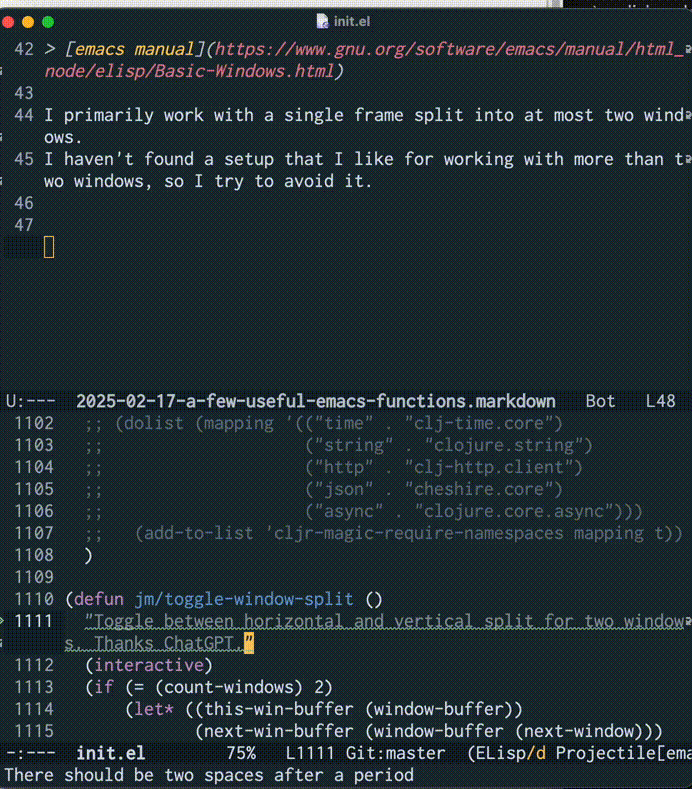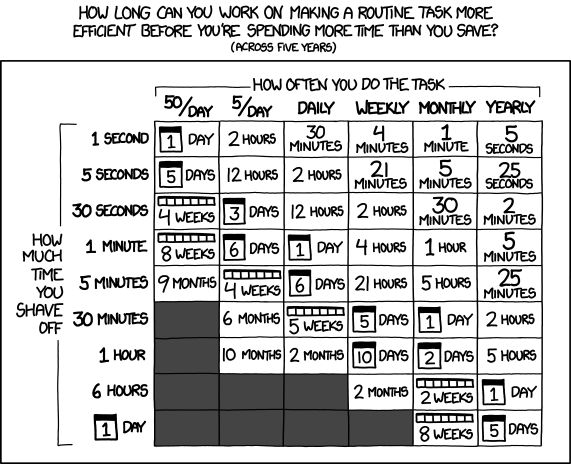I've been using Emacs for nearly twenty years but find it challenging to craft even tiny elisp functions to enhance my workflow. Despite that, I've written elisp to enhance my Emacs experience but I often don't bother fixing small annoyances that are solved relatively easily in other ways. Now that LLMs exist and are reasonably good, they have lowered the bar for creating small quality of life enhancements. Below are two such enhancements.
These have only been tested and used in Emacs 29.4 on macOS.
Quickly change font sizes
I find myself working on a variety of monitor sizes and resolutions. This function lets me quickly switch between font sizes.
(defun jm/choose-font-size ()
"Choose between three different font sizes: 16, 18, and 20."
(interactive)
(set-face-attribute 'default nil :height
(* 10 (string-to-number
(completing-read "Choose font size: "
(mapcar #'number-to-string '(16 18 20)))))))
Change window split orientation
First some definitions from the Emacs manual.
A frame is a screen object that contains one or more Emacs windows (see Windows). It is the kind of object called a “window” in the terminology of graphical environments; but we can’t call it a “window” here, because Emacs uses that word in a different way. - Emacs manual
A window is an area of the screen that can be used to display a buffer (see Buffers). Windows are grouped into frames (see Frames). Each frame contains at least one window; the user can subdivide a frame into multiple, non-overlapping windows to view several buffers at once. - Emacs manual
I primarily work in a single frame split into at most two windows. I haven't found a setup that I like for working with more than two windows, so I avoid it. Often, I'll want to change the split from vertical to horizontal or horizontal to vertical. I hear a picture is worth a thousand words and a gif even more so below is a demo and and the enabling code.

(defun jm/toggle-window-split ()
"Toggle between horizontal and vertical split for two windows. Thanks ChatGPT."
(interactive)
(if (= (count-windows) 2)
(let* ((this-win-buffer (window-buffer))
(next-win-buffer (window-buffer (next-window)))
(this-win-edges (window-edges (selected-window)))
(next-win-edges (window-edges (next-window)))
(this-win-2nd (not (and (<= (car this-win-edges)
(car next-win-edges))
(<= (cadr this-win-edges)
(cadr next-win-edges)))))
(splitter
(if (= (car this-win-edges)
(car (window-edges (next-window))))
'split-window-horizontally
'split-window-vertically)))
(delete-other-windows)
(let ((first-win (selected-window)))
(funcall splitter)
(if this-win-2nd (other-window 1))
(set-window-buffer (selected-window) this-win-buffer)
(set-window-buffer (next-window) next-win-buffer)
(select-window first-win)
(if this-win-2nd (other-window 1))))))
End
Could those functions be written better? I don't know, maybe. If I had to read the documentation and write these entirely on my down, these functions wouldn't exist because the return on investment just wouldn't be there. These only exist because the time to generate them1 is so small that it becomes worth it. AI tools drastically lower the bar for making small routine operations more efficient.
And test and make minor edits as needed.↩
